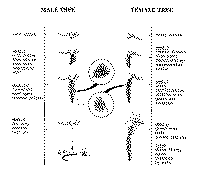Clonal Aspens - Lee Frelich - May
31, 2004
Often you can see
aspens that all turn color at the same time or turn all
the same color in the fall all in one patch, and it is highly
likely that
the color patches indicate clones. Other than that you need to
excavate
the root system or do genetic sampling to see if a patch of aspens
are a
clone. For other tree species clusters are usually caused by
neighborhood
effects other than root sprout clones.
Edward Frank - June 1, 2005
Last week I posted a question concerning how to tell if an aspen
grove was
clonal or grown from seed. Lee pointed out that clonal aspens will
change
color all at the same time.
I have been reading on the internet from a number of sites. One
key to
determining if a grove is a clone grove is that the trees are all
the same
sex. Aspen is dioecious, so individual trees are either male or
female.
Trees flower in March and April, before the leaves appear, with
both the
male and female trees producing catkins. Male catkins produce
yellow
pollen. Female catkins do not preoduce pollen. There also are
morphological differences in the catkins. See illustration from
http://www.devonian.ualberta.ca/pwatch/poplar.htm#TREES

Here are excerpts from some of the internet sites:
http://www.treesforlife.org.uk/tfl.aspen.html
European Aspen
Aspen is dioecious, so individual trees are either male or female
(in
contrast to most trees, such as Scots pine, for example, where
male and
female flowers occur on the same tree). Trees flower in March and
April,
before the leaves appear, with both the male and female trees
producing
catkins. Pollinated female catkins ripen in early summer and
release tiny
seeds (each weighing about one ten-thousandth of a gram!) which
are tufted
with hairs.
Aspen has an extensive root system, and ramets have been recorded
growing
up to 40 metres from a parent tree. Because of their access to
nutrients
through the parent tree's root system, aspen ramets can grow very
quickly -
up to a metre per year for the first few years. As the ramets
grow, they
remain joined through their roots, and all the interconnected
trees are
called a clone. They are all the same individual organism and are
therefore
all single-sexed, either male or female. Each clone exhibits
synchronous
behaviour, with, for example, all the component trees coming into
leaf at
the same time in the spring. A clone can also sometimes be
identified by
the specific colour its leaves change to in the autumn.
http://reference.allrefer.com/wildlife-plants-animals/plants/tree/poptre/
botanical-ecological-characteristics.html
Quaking Aspen
Quaking aspen forms clones connected by a common parent root
system. It
is typically dieocious, with a given clone being either male or
female.
Some clones produce both stamens and pistils, however. Quaking
aspen stands may consist of a single clone or aggregates of
clones.
Clones can be distinguished by differences in phenology, leaf
size and shape, branching habit, bark character, and by
electrophoresis.
http://www.devonian.ualberta.ca/pwatch/poplar.htm#TREES
How to recognize male and female trees before flowering:
Here's a great suggestion from the McKinstrys in Oyen, Alberta:
- in early spring bring a small branch from your poplar tree
(label twigs
with tape if from different trees) into the house and set in a
jar of water
soon the grey tufts (catkins) get longer, turning pinkish
- if the branch is from a male tree the catkins then turn pale
yellow as they
shed a yellow powder (pollen) at the slightest touch. Place a
dark paper or
cloth under jar.
- female catkins do not have pollen
- outdoors, the wind quickly blows pollen away, so try this to
be sure of
your tree
- if the catkins on your outdoor tree eventually turn green,
the tree is
female, and the search for male trees continues!
allrefer.com reference - Quaking Aspen
http://reference.allrefer.com/wildlife-plants-animals/plants/tree/poptre/
botanical-ecological-characteristics.html
Aspen clone takes size prize
http://www.taiga.net/yourYukon/col373.html
After measuring one aspen clone growing near Salt Lake City, Utah,
researchers estimated that it weighs more than 6,000 tonnes,
making it three times heavier than the largest giant sequoia tree
and giving it the record as the world's largest living organism.
Pojar says that there could be bigger aspen clones than Pando
around; it's just that no one has tried to measure them.
"There are huge clones in Alberta as well. You can tell
because they green up in spring and change colour in the fall at
the same time." Aspen that reproduce by cloning can
also be extremely long-lived. Individual stems may live less than
200 years, but the clone itself survives much longer as new stems
continue to replace the dead ones. Some clones are estimated
to be at least 8,000 years old, making them possibly the oldest
organisms on the planet. Some researchers even speculate that
aspen could theoretically be immortal if no natural catastrophe
kills the clone. Fossilized leaves of aspen trees dating back a
million years look almost identical to aspen leaves today.
Nicknamed Pando, Latin for "I spread," this clone covers
an area of more than 43 hectares and has more than 47,000
individual stems.
Quaking Aspen - Bryce Canyon National Park -
http://www.nps.gov/brca/quaking_aspen.html
Botanical Record Breakers -
http://waynesword.palomar.edu/ww0601.htm
Devonian Botanic Garden - Aspen Poplar -
http://www.devonian.ualberta.ca/pwatch/poplar.htm
|